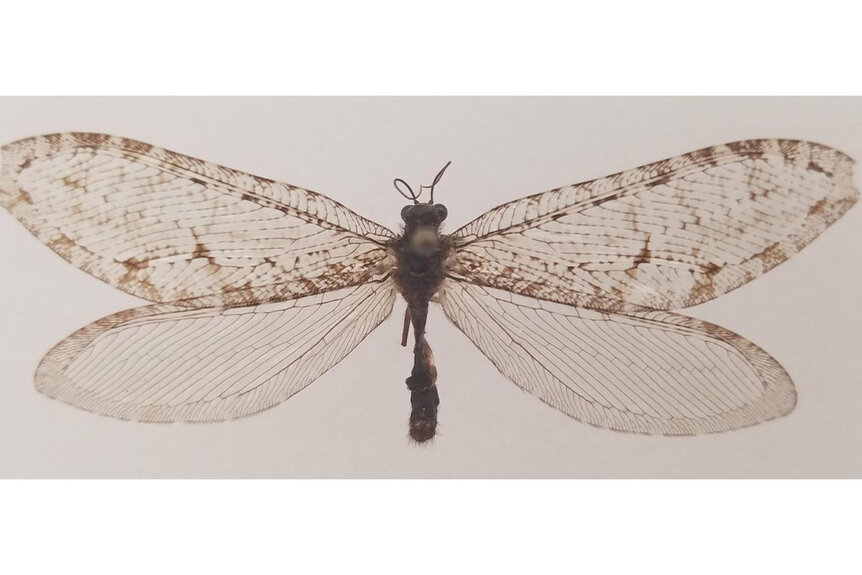Create a free profile to get unlimited access to exclusive videos, sweepstakes, and more!
'Extinct' insect discovered outside Arkansas grocery store
Cue the John Williams score as the sliding doors open.

Generally speaking, if you want to get your hands or eyes on a Jurassic-era animal, you have to go digging in the dirt for fossils or amber. That’s how the over-eager geniuses at InGen did it. At the fictional Mano de Dios Amber Mine, they uncovered mosquitos trapped in amber since the time of the dinosaurs. Using the blood they found inside of those preserved arthropods, they were able to back their way into the most creative way to get rid of a lawyer in human history. See for yourself, in Jurassic Park, streaming right now on Peacock!
If you’re really lucky, however, you might just stumble upon a supposedly extinct animal while you’re out for groceries. That’s what happened to Michael Skvarla, an assistant research professor in the Department of Entomology at Penn State University.
RELATED: Elizabeth Banks explains how 'Evil Dead' and 'Jurassic Park' influenced 'Cocaine Bear'
In 2012, while driving home from a trip, Skvarla and his wife stopped at a Wal-Mart to pick up a few groceries. Skvarla was a PhD student at the University of Arkansas at the time and on the way inside of the store, he saw a winged insect he mistook as an adult antlion.
“The best way to learn how to ID insects is to work on specimens you collected yourself. It helps cement those skills. So, I picked it up and didn’t have anything to put it in, so I walked through Wal-Mart holding it in one hand. We drove home, I mounted it, let it dry out, and put it in my collection,” Skvarla told SYFY WIRE.
And that’s where it sat for the next eight years. Meanwhile, Skvarla graduated and became a professor, which is how he found himself teaching a remote entomology class over Zoom during a global pandemic in the fall of 2020. The course, which usually includes a lot of time in the lab and in the field, instead relied on Skvarla giving lectures and then reinforcing them with observations through a microscope.
“When antlions came up, I brought out my personal antlions, or what I thought were antlions. The first specimen I put under the microscope had none of the characteristics I had just taught my students. It was immediately apparent it wasn’t an antlion,” Skvarla said.
The realization blooming in Skvarla’s mind was shared by his class of students who witnessed the discovery over Zoom. Over the next few minutes, they identified the specimen as that of a giant lacewing, an animal which has never been found in Arkansas before and which was wiped out in the eastern United States decades ago. The discovery was published in the Proceedings of the Entomological Society of Washington.
“Starting in the 1800s, there was a rolling extinction moving westward. By the 1910s, they were gone from Pennsylvania. The farther west you go, the longer they hang on until the 1950s when they finally disappear from Michigan, the last place in the eastern U.S. where you find them. They still exist on the west coast but they’re not super common. We don’t really know why. Then 50 years later, one pops up in Arkansas,” Skvarla said.
RELATED: ‘De-extinction company’ Colossal Biosciences commits to resurrecting the dodo
That single specimen, which now resides at the University where students and scientists can study it, is the only giant lacewing seen within a thousand miles in the last 50 years. Why the giant lacewing went extinct or diminished in the eastern United States isn’t fully understood, but some researchers speculate it may have to do with wildfires. There is some evidence that adult giant lacewings are attracted to smoke and may rely on post-forest fire environments. Forest fires are a significant problem on the West Coast of the United States, but it’s largely contained on the East Coast, which could have been a contributing factor to their disappearance.
Why and how one of them ended up at a supermarket in Arkansas remains a mystery, but Skvarla thinks there are probably more of them tucked away in underexplored areas around the state.
“I think the most likely scenario is there is a small population in the Ozarks of Arkansas that managed to hang on. The Ozarks are a biodiversity hotspot. There are something like 80 insect species that only live in the Ozarks and it’s under-surveyed. If you’re going to be a giant lacewing that’s going to hide out somewhere, you’d probably pick the Ozarks. It’s a good place to go undetected,” Skvarla said.
The good news is, with a keen eye and a little bit of luck, you might be able to find your very own “extinct” animals. And you won’t have to go to a remote island run by a wealthy madman to do it.
That’s an experience we think is best lived vicariously. Catch Jurassic Park, streaming now on Peacock!



























